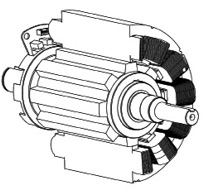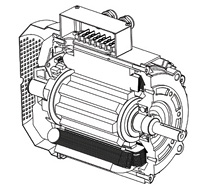The technology behind variable frequency drives (VFD) is nothing new in machine shops and various other industrial applications. But with the advent of faster and more precise switching capabilities of modern microprocessors, the mechanically simple, multi-speed, multi-voltage, variable reluctance motors used in VFDs are poised to make a move into agricultural applications.
In April, DVR Technology Developments Inc. introduced its Digital Variable Reluctance Smart Motor, and is currently selling an off-the-shelf 1.75 horsepower power package on Amazon for $699. Company president Joel Latimer says, “When compared with AC or DC electric motors, the technology involved in the Smart Motor is like jumping from the rotary phone to the smart phone.”
Currently, DVR Technologies, based in St. Petersburg, Fla., is concentrating on motor-and-controller power units ranging from 1-3 horsepower. (5 horsepower maximum on some applications) to be used as replacement power for traditionally designed electric motors on pumps, fans, conveyors, elevator legs, etc.
The variable reluctance motor is easily scalable, say company officials, and OEM equipment makers could easily use similar designs for “prime mover” applications requiring 250 horsepower or more. The technology also lends itself especially well to high-load start-and-stop operating cycles, such as those that might be found on center pivot sprinkler towers.
The Smart Motor is the result of engineering stemming from DVR Technologies, a subsidiary of New Zealand’s Teknatool International, a global manufacturer of electric motors and accessories as well as Nova brand lathes, where variable reluctance motors have been used for more than 10 years. The actual mechanical design, without the microprocessor, dates back to the 1920 invention of the switched brushless direct-current “stepper” motor in England.

This illustration of a digitally switched reluctance motor shows an 8-tooth ferromagnetic rotor operating inside a cage of 12 (6 shown in the cutaway) wired electromagnetic poles. At no time can the rotor completely align with a stator pole, which would lock the rotor.

This illustrates a digitally switched reluctance motor with the addition of the microprocessor control box on top of the motor. The microprocessor rapidly switches stator pole current when the motor is turned on, leading the rotor to move through magnetic attraction (reluctance) from one pole to the next.
Illustrations courtesy of DVR Technology Developments
DVR Smart Motors (digitally switched) get their name from the fact that they can communicate wirelessly with the operator about operating temperature and vibration as well as bearing resistance, says spokesperson Sabrina Latimer. “This off-site monitoring capability will provide farmers the knowledge of motors in remote areas that might need attention, long before the motor fails,” she explains. “As a pump motor, the communication ability also could monitor pump pressures and alert the operator when pressures fall or spike.”
Additionally, DVR’s motors are designed as 3-phase motors, but because of their unique design, they can operate on single-phase current if the other two phases are interrupted or if brownouts occur.
How They Work
A variable reluctance motor has 3 basic parts: A stator with wound poles, an iron-based rotor attached directly to the output shaft and a microprocessor.
The stator carries electricity controlled by the microprocessor and provides an intense electromagnetic field that “attracts” the nearest laminated iron “tooth” of the rotor. This causes it to rotate the output shaft as it seeks to align with the pole. Before it can align, however, the microprocessor switches off the pole and excites the next pole, to keep the rotor spinning. At operating speeds, the microprocessor switches on the poles to lead the rotor at the designed speed and torque specifications of the motor.
In the case of the DVR equipment, the microprocessor computes spindle position 400 times a second in its work to keep the rotor spinning.
The rotors of reluctance motors will have fewer teeth than the stator has wound coils. This prevents rotor teeth from becoming magnetically aligned with a pole and locking the rotor.
VR Motors & Farming
In this column over the past 2 issues of Farm Equipment, we’ve discussed the coming electrification of tractors and implements, and the data link upgrades underway on the drawing boards of farm equipment OEMs. The variable reluctance motor is technology that fits neatly into both of those engineering challenges.
Because of their simple construction — no brushes, no permanent magnets and no electrical connections to rotating parts — variable reluctance motors have a long operating life and low maintenance requirements.
As power units for spreaders, sprayers, unloaders, fans and various systems on balers and harvesters, VR motors provide extremely high torque output at low speeds. They operate with significantly lower current requirements than traditional electric motors with far less heat generation, plumbing and weight than hydraulic or mechanical drive systems.
“The technology lends itself especially well to high-load start-and-stop operating cycles…”
The ability of these motors and their microprocessors to communicate with a tractor ECU, particularly through proposed enhanced Ethernet or ISOBUS connections, will allow even more precise automated control of the implement and tractor combination. As engineering moves to more “implement control” of the tractor, VR motors will play a big part in generating the cues needed to put the right amount of power on the ground for the most efficient operation of whatever implement or system is being used.
Unlike traditional electric motors that are optimized at a very narrow operating speed and power band, VR motor design has the capability of operating at speeds of under 100 rpm to 100,000 rpm. VR motors also can be used as “stepper” motors — moving one rotor tooth at a time, forward or backward. Because of the variable speed capabilities, VR motors can be attached directly to a load, without the need for gears, pulleys or belts, reducing manufacturing and maintenance costs.







